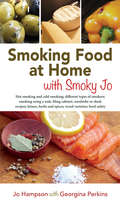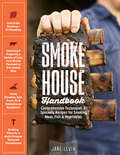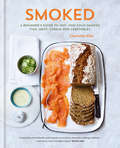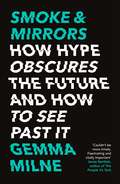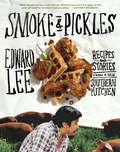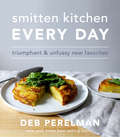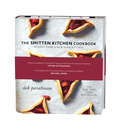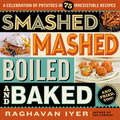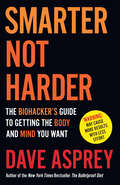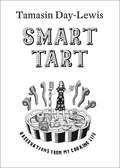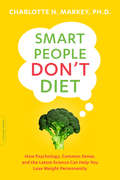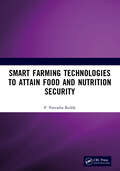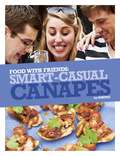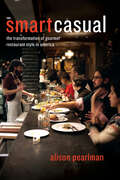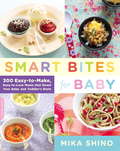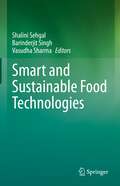- Table View
- List View
SMOKING FOOD AT HOME WITH SMOKY JO: HOT SMOKING AND COLD SMOKING; DIFFERENT TYPES OF SMOKERS; SMOKING USING A WOK, A FILING CABINET, WARDROBE OR SHED; RECIPES; BRINES, HERBS AND SPICES; WOOD VARIETIES; FOOD SAFETY
by JO HAMPSONSmoking Food is an art not a science. In this easy-to-follow accessible, no-nonsense, informative book the authors, who are masters of their craft, have removed the mystery and imparted the fun into smoing food. The book guides the reader through the principles, variations and options in being able to create and enjoy smoked food recipes at home.
Smokehouse Handbook: Comprehensive Techniques & Specialty Recipes for Smoking Meat, Fish & Vegetables
by Jake LevinA comprehensive guide to cold-smoking, hot-smoking, and pit-roasting techniques from a master butcher who provides expert advice on every aspect of selecting, preparing, and cooking meat, fish, and vegetables.
Smoked: A Beginner's Guide To Hot- And Cold-smoked Fish, Meat, Cheese, And Vegetables
by Charlotte PikeSmoking is one of the oldest and most delicious ways of preserving and flavouring a wide range of food, from fish and meat to vegetables and dairy products. Charlotte Pike provides an essential guide for anyone who wants to try their hand at this ancient technique - whether a beginner or more experienced cook - with step-by-step instructions for both hot and cold smoking, as well as guidance on ready-to-use equipment to suit all budgets, from stovetop smoking to mastering the Big Green Egg and even building your own DIY cold smoker. With an inspiring variety of tried-and-tested recipes for smoked ingredients, plus dishes to showcase them, including smoked chicken and chorizo paella, cold-smoked salmon platter, Asian smoked mackerel salad, melanzane parmigiana with smoked mozzarella and barbecued lobster with smoked butter, this is your go-to smoking guide, filled with irresistible recipes to savour and share.
Smoke & Mirrors: How Hype Obscures the Future and How to See Past It
by Gemma Milne'Stop following the news until you've read Gemma Milne's persuasive analysis of the hype and bullshit that distort our understanding of emerging science. As she shows, the starting point to grasping the genuine opportunities of AI, life sciences and climate tech is a healthy dose of critical thinking'David Rowan, founding editor of WIRED UK and author of Non-Bullshit Innovation: Radical Ideas from the World's Smartest Minds'Couldn't be more timely. Fascinating and vitally important' Jamie Bartlett, author of The People Vs Tech 'A much-needed blast of fresh air! Gemma Milne expertly shows us how to separate the truth from the hype surrounding the emerging techs of today, and those of the near-tomorrow.' Lewis Dartnell, author of Origins: How the Earth Made Us'I loved this book! This is exactly the sort of sceptical, cut-through-the crap-but-still-excited-about-what's-emerging book around tech innovation that's sorely needed, yet is so hard to find . . . essential reading for anyone who's serious about how real-world advances might be effectively harnessed to build a better future.' Dr Andrew Maynard, scientist and author of Films from the Future and Future Rising'Smoke & Mirrors is a vital contribution in a world where technological progress promises so much, but too often disappoints. If, like me, you believe that advances in science and technology are our best hope for solving the grand challenges of our times, this book is the indispensable guide to avoiding the mirages and the charlatans along the way.' Matt Clifford, co-founder and CEO of Entrepreneur First'A refreshingly grown-up, clear-headed look at the interaction between science, technology and the media - readable without being dumbed down, acknowledging complexities without being heavy.' Tom Chivers, author of The AI Does Not Hate You'In this book, we see technological hype for what it is: not mere exuberance, but a form of attention-seeking. As some technological hucksters stake claims on our future and try to foreclose alternatives, we need strong defences. Gemma Milne offers a spotter's guide to hype, using science to bring speculation down to earth. People inside and outside the world of technological innovation need this book.' Jack Stilgoe, author of Who's Driving Innovation?'ROBOTS WILL STEAL YOUR JOB!''AI WILL REVOLUTIONISE FARMING!''GENETIC EDITING WILL CURE CANCER!'Bombastic headlines about science and technology are nothing new. To cut through the constant stream of information and misinformation on social media, or grab the attention of investors, or convince governments to take notice, strident headlines or bold claims seem necessary to give complex, nuanced information some wow factor.But hype has a dark side, too.It can mislead. It can distract. It can blinker us from seeing what is actually going on.From AI, quantum computing and brain implants, to cancer drugs, future foods and fusion energy, science and technology journalist Gemma Milne reveals hype to be responsible for fundamentally misdirecting or even derailing crucial progress.Hype can be combated and discounted, though, if you're able to see exactly where, how and why it is being deployed.This book is your guide to doing just that.
Smoke and Pickles: Recipes and Stories from a New Southern Kitchen
by Edward LeeChef Edward Lee's story and his food could only happen in America. Raised in Brooklyn by a family of Korean immigrants, he eventually settled down in his adopted hometown of Louisville, Kentucky, where he owns the acclaimed restaurant 610 Magnolia. A multiple James Beard Award nominee for his unique patchwork cuisine, Edward creates recipes--filled with pickling, fermenting, frying, curing, and smoking--that reflect the overlapping flavors and techniques that led this Korean-American boy to feel right at home in the South. Dishes like Chicken-Fried Pork Steak with Ramen Crust and Buttermilk Pepper Gravy; Collards and Kimchi; Braised Beef Kalbi with Soft Grits and Scallions; and Miso-Smothered Chicken all share a place on his table. Born with the storytelling gene of a true Southerner, Lee fills his debut cookbook with tales of the restaurant world, New York City, Kentucky, and his time competing on Top Chef, plus more than 130 exceptional recipes for food with Korean roots and Southern soul.
Smitten Kitchen Every Day: Triumphant and Unfussy New Favorites
by Deb Perelman'This is one to enjoy from cover to cover' - Booklist'Recipes that are ingeniously creative but so accessible' - Whiteny Filloon, EaterDeb Perelman, award-winning blogger and New York Times best-selling author of The Smitten Kitchen Cookbook, understands that a happy discovery in the kitchen has the ability to completely change the course of your day. Whether we’re cooking for ourselves, for a date night in, for a Sunday supper with friends, or for family on a busy weeknight, we all want recipes that are unfussy to make with triumphant results. Deb thinks that cooking should be an escape from drudgery. Smitten Kitchen Every Day: Triumphant and Unfussy New Favorites presents more than one hundred impossible-to-resist recipes—almost all of them brand-new, plus a few favorites from her website—that will make you want to stop what you’re doing right now and cook. These are real recipes for real people—people with busy lives who don’t want to sacrifice flavor or quality to eat meals they’re really excited about.You’ll want to put these recipes in your Forever Files: Sticky Toffee Waffles (sticky toffee pudding you can eat for breakfast), Everything Drop Biscuits with Cream Cheese, and Magical Two-Ingredient Oat Brittle (a happy accident). There’s a (hopelessly, unapologetically inauthentic) Kale Caesar with Broken Eggs and Crushed Croutons, a Mango Apple Ceviche with Sunflower Seeds, and a Grandma-Style Chicken Noodle Soup that fixes everything. You can make Leek, Feta, and Greens Spiral Pie, crunchy Brussels and Three Cheese Pasta Bake that tastes better with brussels sprouts than without, Beefsteak Skirt Steak Salad, and Bacony Baked Pintos with the Works (as in, giant bowls of beans that you can dip into like nachos). And, of course, no meal is complete without cake (and cookies and pies and puddings): Chocolate Peanut Butter Icebox Cake (the icebox cake to end all icebox cakes), Pretzel Linzers with Salted Caramel, Strawberry Cloud Cookies, Bake Sale Winning-est Gooey Oat Bars, as well as the ultimate Party Cake Builder—four one-bowl cakes for all occasions with mix-and-match frostings (bonus: less time spent doing dishes means everybody wins).Written with Deb’s trademark humor and gorgeously illustrated with her own photographs, Smitten Kitchen Every Day is filled with what are sure to be your new favorite things to cook.
The Smitten Kitchen Cookbook
by Deb PerelmanYou don't need to be a chef, you don't need special ingredients, you don't even need a big kitchen. There is a half-galley kitchen in New York with just a single counter, a tiny stove, pans stacked high in the corner - yet it has conjured up stews and slaws, salsas and pestos, tatins and cheesecakes. All to-die-for.This is Deb Perelman's kitchen. Deb is an ordinary home cook who believes food should be a pleasure and deliciousness a guarantee. So she founded www.smittenkitchen.com, her award-winning blog, where she concocts, tweaks and obsessively tests the best imaginable recipes for the everyday cook. These are recipes you'll bookmark, share, and make your own, whether it is Courgette Ribbons with Almond Pesto for a summer lunch, Everyday Margherita Pizza for the family, Seared Halibut with Gazpacho Salsa for a weekend dinner, or Tiny But Intense Chocolate Cake for a special treat.'I'm a longtime fan of the blog and this is a wonderful cookbook' Rachel Khoo, Little Paris Kitchen
Smashed, Mashed, Boiled, and Baked--and Fried, Too!: A Celebration of Potatoes in 75 Irresistible Recipes
by Raghavan Iyer75 glorious recipes from around the world, featuring everyone's favorite comfort food - a collection that will explode your idea of what it means to eat and love potatoes.
Smarter Not Harder: The Biohacker's Guide To Getting The Body And Mind You Want
by Dave AspreyWorld-renowned biohacker and bestselling author Dave Asprey reveals how to maximize your well-being with the minimum effort, by taking control of your body’s operating system.
Smart Tart: Observations From My Cooking Life
by Tamasin Day-LewisThe Art of the Tart appealed to cooks of all ages and abilities, even those who didn't 'do' pastry. Smart Tart is a book about food and how it defines us – in 15 autobiographical sketches, Tamasin takes us back to early memories of making jam tarts with her mother, the matchless taste of the Bakewell tart made by her grandparents' cook Rhoda, her father's elaborate Christmas rituals and the pleasures of tea at Fortnum & Mason with her brother Daniel. She writes at length of the beauty and restorative power of County Mayo in the west of Ireland and of the important role food played in the social revolution of the 1960s. In one of the most powerful pieces in the book she recounts six months teaching a group of local mums how to cook as part of a Homestart programme and how it transformed their lives.
Smart People Don't Diet: How the Latest Science Can Help You Lose Weight Permanently
by Charlotte MarkeyForget the fad diets: an associate professor of psychology (Rutgers) offers a science-based approach to healthy eating and weight management (backed by research from scientists, doctors, nutritionists, and psychologists).
Smart Foods for ADHD and Brain Health: How Nutrition Influences Cognitive Function, Behaviour and Mood
by Rachel GowChanging one's diet not only improves physical health, but benefits mood, behaviour and cognitive function at a fundamental level. This book highlights the link between nutrition and mental health and demonstrates the crucial role of diet in supporting individuals with ADHD. Written by an internationally-recognised leader in the growing field of nutritional psychiatry, Dr Rachel Gow takes a nutrition-based look at ADHD and its management. Combining the latest research with the inspirational stories of a range of professionals and individuals whose lives have been touched by the issues raised, this book also includes accessible tips throughout and a chapter of recipes to promote brain health. This is an essential guide to understanding the interplay of brain health and nutrition, and supporting families to build a diet that optimises brain function and health.
Smart Foods for ADHD and Brain Health: How Nutrition Influences Cognitive Function, Behaviour and Mood
by Rachel GowChanging one's diet not only improves physical health, but benefits mood, behaviour and cognitive function at a fundamental level. This book highlights the link between nutrition and mental health and demonstrates the crucial role of diet in supporting individuals with ADHD. Written by an internationally-recognised leader in the growing field of nutritional psychiatry, Dr Rachel Gow takes a nutrition-based look at ADHD and its management. Combining the latest research with the inspirational stories of a range of professionals and individuals whose lives have been touched by the issues raised, this book also includes accessible tips throughout and a chapter of recipes to promote brain health. This is an essential guide to understanding the interplay of brain health and nutrition, and supporting families to build a diet that optimises brain function and health.
Smart Farming Technologies to Attain Food and Nutrition Security
by P. Parvatha ReddyThe concept of Rainbow Revolution is an integrated development of crop cultivation, horticulture, forestry, fishery, poultry, animal husbandry, and food processing industry. The concept of Smart Farming Technologies in agriculture is a step towards sustainability. India has already achieved resilience in agriculture, including the horticultural sector, through effective agricultural technology generation and is now on the threshold of a “rainbow revolution” that will ensure both household nutrition security and prosperity for its people. This book will be of immense value to the scientific community involved in teaching, research and extension activities related to strategies for achieving Rainbow Revolution for enhancing farmers’ income, food, and nutrition security. The book can also serve as a very useful reference for policymakers and practicing farmers.
Smart Farming Technologies to Attain Food and Nutrition Security
by P. Parvatha ReddyThe concept of Rainbow Revolution is an integrated development of crop cultivation, horticulture, forestry, fishery, poultry, animal husbandry, and food processing industry. The concept of Smart Farming Technologies in agriculture is a step towards sustainability. India has already achieved resilience in agriculture, including the horticultural sector, through effective agricultural technology generation and is now on the threshold of a “rainbow revolution” that will ensure both household nutrition security and prosperity for its people. This book will be of immense value to the scientific community involved in teaching, research and extension activities related to strategies for achieving Rainbow Revolution for enhancing farmers’ income, food, and nutrition security. The book can also serve as a very useful reference for policymakers and practicing farmers.
Smart Cookie: Transform Store-Bought Cookies Into Amazing Treats
by Christi JohnstoneIt's fun to bake, but it's really fun to decorate!Everyone knows the best part about making cookies is the decorating! Smart Cookie includes 50 simple and fun cookie creations made entirely from easy-to-find store-bought ingredients-no baking required! Projects include rainbows, monster pops, balloons, robots, ladybugs, and much more, with lots of ideas for tips, techniques, packaging, and displays.From birthdays to graduations and baby showers to Christmas, there is a cookie in this book for any and all occasions. If you love to decorate cookies, are looking for imaginative ways to celebrate holidays and special moments, this book is for you!
Smart Casual Canapés
by The Sorted Crew Ben EbbrellSmart-Casual Canapés is the third chapter from The Sorted Crew's new cookbook, Food with Friends.Things seem so much more sophisticated when translated into French, but while the word canapé sounds pretty classy, these bite-sized appetisers are actually just finger food. The real trick is to make them look as posh as they sound, so each canapé in this chapter is stupidly simple to make, but when you put four or five together they look really impressive. Recipes include: Jerk Chicken Potato Wedges, Mango, Coriander and Crayfish Sticks, Micro Jackets with Guacamole and Tequila Salmon Gravadlax.Food with Friends is the second cookbook from The Sorted Crew, with recipes by Ben Ebbrell. It's the ultimate guide for entertaining friends in a fun and fuss-free way, from romantic suppers and family barbecues to curry nights for hungry hordes. Whether you're cooking for two or twenty, Food with Friends by The Sorted Crew is THE book for easy entertaining.The Sorted Crew came together in their university holidays, sharing their cooking highs and lows with each other in the pub. Headed up by Ben Ebbrell and Barry Taylor, this original group of 8 mates with an interest in food has now grown into a highly engaged online community of hundreds of thousands, that works together to get food challenges sorted. The SortedFood video recipes on YouTube now get millions of views every month. They self-published two recipe books, A Recipe for Student Survival and A Rookie's Guide to Crackin' Cooking, and Beginners... Get Sorted was their first book with Penguin.
Smart Casual: The Transformation of Gourmet Restaurant Style in America
by Alison PearlmanFine dining and the accolades of Michelin stars once meant chandeliers, white tablecloths, and suited waiters with elegant accents. The stuffy attitude and often scant portions were the punchlines of sitcom jokes—it was unthinkable that a gourmet chef would stoop to plate a burger or a taco in his kitchen. And yet today many of us will queue up for a seat at a loud, crowded noodle bar or eagerly seek out that farm-to-table restaurant where not only the burgers and fries are organic but the ketchup is homemade—but it’s not just us: the critics will be there too, ready to award distinction. Haute has blurred with homey cuisine in the last few decades, but how did this radical change happen, and what does it say about current attitudes toward taste? Here with the answers is food writer Alison Pearlman. In Smart Casual: The Transformation of Gourmet Restaurant Style in America, Pearlman investigates what she identifies as the increasing informality in the design of contemporary American restaurants. By design, Pearlman does not just mean architecture. Her argument is more expansive—she is as interested in the style and presentation of food, the business plan, and the marketing of chefs as she is in the restaurant’s floor plan or menu design. Pearlman takes us hungrily inside the kitchens and dining rooms of restaurants coast to coast—from David Chang’s Momofuku noodle bar in New York to the seasonal, French-inspired cuisine of Alice Waters and Thomas Keller in California to the deconstructed comfort food of Homaro Cantu’s Moto in Chicago—to explore the different forms and flavors this casualization is taking. Smart Casual examines the assumed correlation between taste and social status, and argues that recent upsets to these distinctions have given rise to a new idea of sophistication, one that champions the omnivorous. The boundaries between high and low have been made flexible due to our desire to eat everything, try everything, and do so in a convivial setting. Through lively on-the-scene observation and interviews with major players and chefs, Smart Casual will transport readers to restaurants around the country to learn the secrets to their success and popularity. It is certain to give foodies and restaurant-goers something delectable to chew on.
Smart Casual: The Transformation of Gourmet Restaurant Style in America
by Alison PearlmanFine dining and the accolades of Michelin stars once meant chandeliers, white tablecloths, and suited waiters with elegant accents. The stuffy attitude and often scant portions were the punchlines of sitcom jokes—it was unthinkable that a gourmet chef would stoop to plate a burger or a taco in his kitchen. And yet today many of us will queue up for a seat at a loud, crowded noodle bar or eagerly seek out that farm-to-table restaurant where not only the burgers and fries are organic but the ketchup is homemade—but it’s not just us: the critics will be there too, ready to award distinction. Haute has blurred with homey cuisine in the last few decades, but how did this radical change happen, and what does it say about current attitudes toward taste? Here with the answers is food writer Alison Pearlman. In Smart Casual: The Transformation of Gourmet Restaurant Style in America, Pearlman investigates what she identifies as the increasing informality in the design of contemporary American restaurants. By design, Pearlman does not just mean architecture. Her argument is more expansive—she is as interested in the style and presentation of food, the business plan, and the marketing of chefs as she is in the restaurant’s floor plan or menu design. Pearlman takes us hungrily inside the kitchens and dining rooms of restaurants coast to coast—from David Chang’s Momofuku noodle bar in New York to the seasonal, French-inspired cuisine of Alice Waters and Thomas Keller in California to the deconstructed comfort food of Homaro Cantu’s Moto in Chicago—to explore the different forms and flavors this casualization is taking. Smart Casual examines the assumed correlation between taste and social status, and argues that recent upsets to these distinctions have given rise to a new idea of sophistication, one that champions the omnivorous. The boundaries between high and low have been made flexible due to our desire to eat everything, try everything, and do so in a convivial setting. Through lively on-the-scene observation and interviews with major players and chefs, Smart Casual will transport readers to restaurants around the country to learn the secrets to their success and popularity. It is certain to give foodies and restaurant-goers something delectable to chew on.
Smart Casual: The Transformation of Gourmet Restaurant Style in America
by Alison PearlmanFine dining and the accolades of Michelin stars once meant chandeliers, white tablecloths, and suited waiters with elegant accents. The stuffy attitude and often scant portions were the punchlines of sitcom jokes—it was unthinkable that a gourmet chef would stoop to plate a burger or a taco in his kitchen. And yet today many of us will queue up for a seat at a loud, crowded noodle bar or eagerly seek out that farm-to-table restaurant where not only the burgers and fries are organic but the ketchup is homemade—but it’s not just us: the critics will be there too, ready to award distinction. Haute has blurred with homey cuisine in the last few decades, but how did this radical change happen, and what does it say about current attitudes toward taste? Here with the answers is food writer Alison Pearlman. In Smart Casual: The Transformation of Gourmet Restaurant Style in America, Pearlman investigates what she identifies as the increasing informality in the design of contemporary American restaurants. By design, Pearlman does not just mean architecture. Her argument is more expansive—she is as interested in the style and presentation of food, the business plan, and the marketing of chefs as she is in the restaurant’s floor plan or menu design. Pearlman takes us hungrily inside the kitchens and dining rooms of restaurants coast to coast—from David Chang’s Momofuku noodle bar in New York to the seasonal, French-inspired cuisine of Alice Waters and Thomas Keller in California to the deconstructed comfort food of Homaro Cantu’s Moto in Chicago—to explore the different forms and flavors this casualization is taking. Smart Casual examines the assumed correlation between taste and social status, and argues that recent upsets to these distinctions have given rise to a new idea of sophistication, one that champions the omnivorous. The boundaries between high and low have been made flexible due to our desire to eat everything, try everything, and do so in a convivial setting. Through lively on-the-scene observation and interviews with major players and chefs, Smart Casual will transport readers to restaurants around the country to learn the secrets to their success and popularity. It is certain to give foodies and restaurant-goers something delectable to chew on.
Smart Casual: The Transformation of Gourmet Restaurant Style in America
by Alison PearlmanFine dining and the accolades of Michelin stars once meant chandeliers, white tablecloths, and suited waiters with elegant accents. The stuffy attitude and often scant portions were the punchlines of sitcom jokes—it was unthinkable that a gourmet chef would stoop to plate a burger or a taco in his kitchen. And yet today many of us will queue up for a seat at a loud, crowded noodle bar or eagerly seek out that farm-to-table restaurant where not only the burgers and fries are organic but the ketchup is homemade—but it’s not just us: the critics will be there too, ready to award distinction. Haute has blurred with homey cuisine in the last few decades, but how did this radical change happen, and what does it say about current attitudes toward taste? Here with the answers is food writer Alison Pearlman. In Smart Casual: The Transformation of Gourmet Restaurant Style in America, Pearlman investigates what she identifies as the increasing informality in the design of contemporary American restaurants. By design, Pearlman does not just mean architecture. Her argument is more expansive—she is as interested in the style and presentation of food, the business plan, and the marketing of chefs as she is in the restaurant’s floor plan or menu design. Pearlman takes us hungrily inside the kitchens and dining rooms of restaurants coast to coast—from David Chang’s Momofuku noodle bar in New York to the seasonal, French-inspired cuisine of Alice Waters and Thomas Keller in California to the deconstructed comfort food of Homaro Cantu’s Moto in Chicago—to explore the different forms and flavors this casualization is taking. Smart Casual examines the assumed correlation between taste and social status, and argues that recent upsets to these distinctions have given rise to a new idea of sophistication, one that champions the omnivorous. The boundaries between high and low have been made flexible due to our desire to eat everything, try everything, and do so in a convivial setting. Through lively on-the-scene observation and interviews with major players and chefs, Smart Casual will transport readers to restaurants around the country to learn the secrets to their success and popularity. It is certain to give foodies and restaurant-goers something delectable to chew on.
Smart Casual: The Transformation of Gourmet Restaurant Style in America
by Alison PearlmanFine dining and the accolades of Michelin stars once meant chandeliers, white tablecloths, and suited waiters with elegant accents. The stuffy attitude and often scant portions were the punchlines of sitcom jokes—it was unthinkable that a gourmet chef would stoop to plate a burger or a taco in his kitchen. And yet today many of us will queue up for a seat at a loud, crowded noodle bar or eagerly seek out that farm-to-table restaurant where not only the burgers and fries are organic but the ketchup is homemade—but it’s not just us: the critics will be there too, ready to award distinction. Haute has blurred with homey cuisine in the last few decades, but how did this radical change happen, and what does it say about current attitudes toward taste? Here with the answers is food writer Alison Pearlman. In Smart Casual: The Transformation of Gourmet Restaurant Style in America, Pearlman investigates what she identifies as the increasing informality in the design of contemporary American restaurants. By design, Pearlman does not just mean architecture. Her argument is more expansive—she is as interested in the style and presentation of food, the business plan, and the marketing of chefs as she is in the restaurant’s floor plan or menu design. Pearlman takes us hungrily inside the kitchens and dining rooms of restaurants coast to coast—from David Chang’s Momofuku noodle bar in New York to the seasonal, French-inspired cuisine of Alice Waters and Thomas Keller in California to the deconstructed comfort food of Homaro Cantu’s Moto in Chicago—to explore the different forms and flavors this casualization is taking. Smart Casual examines the assumed correlation between taste and social status, and argues that recent upsets to these distinctions have given rise to a new idea of sophistication, one that champions the omnivorous. The boundaries between high and low have been made flexible due to our desire to eat everything, try everything, and do so in a convivial setting. Through lively on-the-scene observation and interviews with major players and chefs, Smart Casual will transport readers to restaurants around the country to learn the secrets to their success and popularity. It is certain to give foodies and restaurant-goers something delectable to chew on.
Smart Casual: The Transformation of Gourmet Restaurant Style in America
by Alison PearlmanFine dining and the accolades of Michelin stars once meant chandeliers, white tablecloths, and suited waiters with elegant accents. The stuffy attitude and often scant portions were the punchlines of sitcom jokes—it was unthinkable that a gourmet chef would stoop to plate a burger or a taco in his kitchen. And yet today many of us will queue up for a seat at a loud, crowded noodle bar or eagerly seek out that farm-to-table restaurant where not only the burgers and fries are organic but the ketchup is homemade—but it’s not just us: the critics will be there too, ready to award distinction. Haute has blurred with homey cuisine in the last few decades, but how did this radical change happen, and what does it say about current attitudes toward taste? Here with the answers is food writer Alison Pearlman. In Smart Casual: The Transformation of Gourmet Restaurant Style in America, Pearlman investigates what she identifies as the increasing informality in the design of contemporary American restaurants. By design, Pearlman does not just mean architecture. Her argument is more expansive—she is as interested in the style and presentation of food, the business plan, and the marketing of chefs as she is in the restaurant’s floor plan or menu design. Pearlman takes us hungrily inside the kitchens and dining rooms of restaurants coast to coast—from David Chang’s Momofuku noodle bar in New York to the seasonal, French-inspired cuisine of Alice Waters and Thomas Keller in California to the deconstructed comfort food of Homaro Cantu’s Moto in Chicago—to explore the different forms and flavors this casualization is taking. Smart Casual examines the assumed correlation between taste and social status, and argues that recent upsets to these distinctions have given rise to a new idea of sophistication, one that champions the omnivorous. The boundaries between high and low have been made flexible due to our desire to eat everything, try everything, and do so in a convivial setting. Through lively on-the-scene observation and interviews with major players and chefs, Smart Casual will transport readers to restaurants around the country to learn the secrets to their success and popularity. It is certain to give foodies and restaurant-goers something delectable to chew on.
Smart Bites for Baby: 300 Easy-to-Make, Easy-to-Love Meals that Boost Your Baby and Toddler's Brain
by Mika ShinoEven though we know that babies and children learn primarily through their senses, American babies are still eating mushy food from a jar--at a time when their brains are growing exponentially and they are most open to trying new things. Smart Bites for Baby offers a better approach to cooking for babies and toddlers. Drawing on world cuisine, this cookbook includes 300 easy recipes made with nutrient-rich ingredients, such as fish, berries, and sesame. The meals emphasize color, texture, and flavor, and are proven to engage and stimulate the growing brain. Parents will also find more nutritious versions of the foods toddlers love, from mac n&’ cheese to popsicles. Shino&’s smart bites nourish the minds and bodies of our children.
Smart and Sustainable Food Technologies
by Shalini Sehgal Barinderjit Singh Vasudha SharmaThis book presents a comprehensive view of emerging smart technologies in various food processing sectors. Specifically, it covers smart technologies applied in food production, food manufacturing, food packaging, storage, distribution, and food supply chain. Contributing authors are the key scientists with diverse backgrounds in either industry or academia.The book contains four parts with four chapters each, presenting recent smart technologies developed in their respective areas. Part I primarily focuses on the recent smart food production innovations such as precision agriculture, vertical farming, automation, robotics , livestock technology, modern greenhouse practices, artificial intelligence, and block chain that dramatically increase the quality of raw materials for the food industry. Part II provides the current knowledge and developments related to the recent smart technologies in manufacturing pertaining to various food sectors, non-thermal food preservation technologies, and 3D printing, developed for the food manufacturing industries that improve the organoleptic and nutritional quality, enhance chemical and microbial safety, as well as cost-effectiveness and convenience of processed foods. Part III covers smart technologies to ensure food safety in the supply chain, with monitoring and surveillance of food contamination, use of IoT and blockchain for food traceability and neural network approach for risk assessment. Part IV provides expert opinions on using smart technologies for minimizing waste and maximizing co-product recovery in food processing; upcycling technologies in food and sustainable value stream mapping in the food industry.This book will be a useful resource to graduate/undergraduate students and researchers in advanced food technology, practicing technologists/engineers in the food and related industries, food packaging industry, entrepreneurs and other scientists and technologists in smart and sustainable processes who seek information on design and development of these processes.
